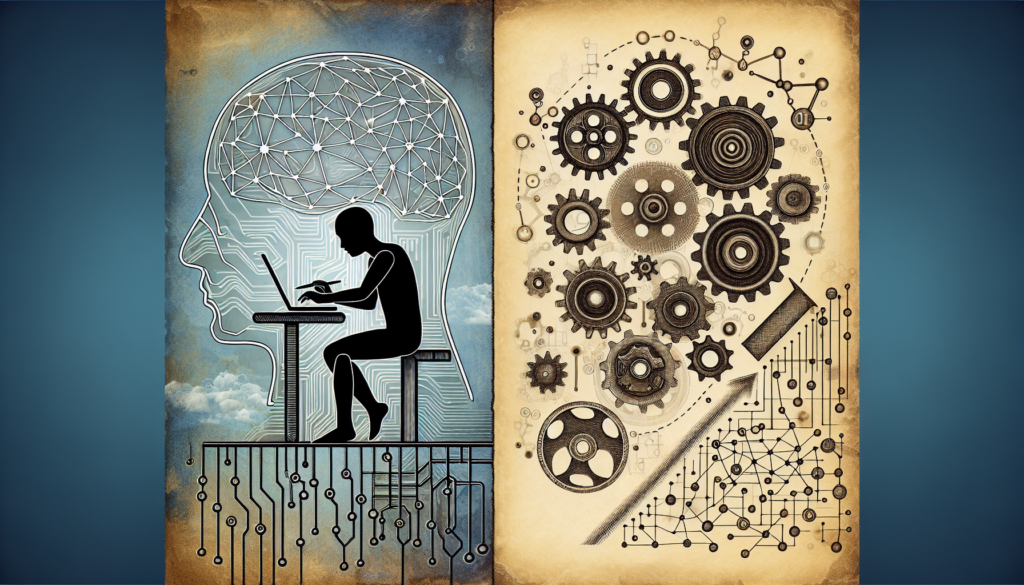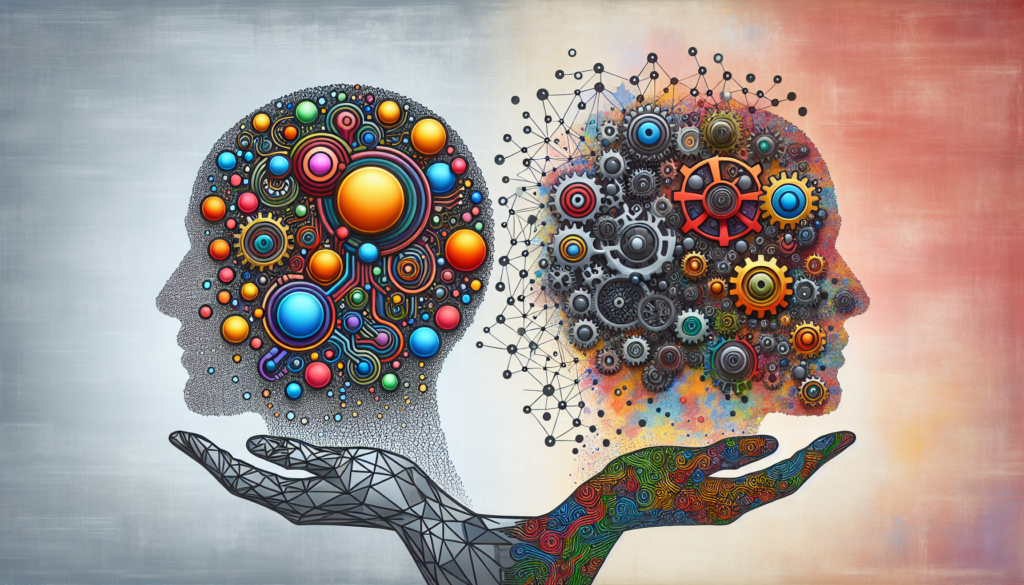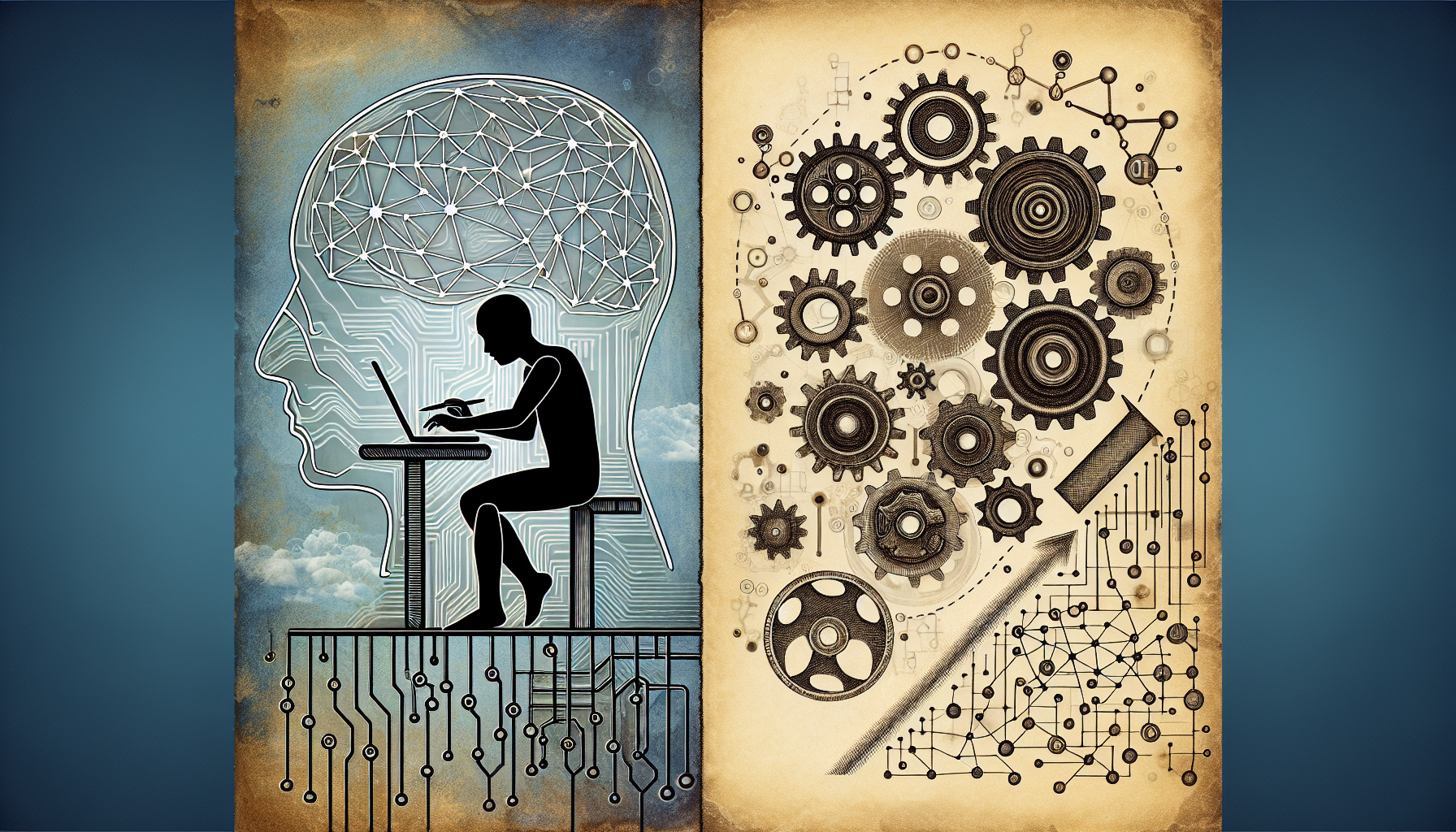AI, short for Artificial Intelligence, is a term that seems to be everywhere these days, but what exactly does it mean? Often used interchangeably with Machine Learning (ML), it can be easy to confuse the two. In this article, we will shed light on the distinct differences between AI and ML, unraveling the mystery behind these buzzwords that have taken the tech world by storm. So, if you’ve ever found yourself pondering the true essence of AI without the influence of ML, then this is the article for you. Brace yourself for an enlightening journey into the realm of AI, where we will explore its fascinating features and separate it from its machine learning counterpart. AI, or artificial intelligence, is a broad term that encompasses various technologies and systems designed to emulate human intelligence and perform tasks that usually require human intelligence. On the other hand, machine learning (ML) refers to a specific subset of AI that focuses on the development of algorithms and models that can learn from data and make predictions or take actions based on that learning.
Defining Artificial Intelligence (AI)
Artificial intelligence, in its simplest form, refers to the simulation of human intelligence in machines, allowing them to mimic human behaviors and cognitive processes. It involves the development of intelligent systems that can perceive their environment, reason, learn, and make decisions or take actions to solve problems. AI encompasses a wide range of technologies, including ML, but also includes other techniques and approaches.
Defining Machine Learning (ML)
Machine learning is a subset of AI that focuses on enabling machines to learn from data without being explicitly programmed. ML algorithms and models are trained using data, through which they identify patterns, make predictions, or take specific actions. Unlike traditional programming methods, where explicit instructions are provided, ML algorithms rely on patterns and statistical analysis to make informed decisions. It is a powerful tool that forms a crucial part of AI.
Differentiating AI and ML
While machine learning is a subset of AI, it is important to understand that AI encompasses techniques and technologies beyond ML. AI includes rule-based systems, expert systems, search and optimization algorithms, natural language processing (NLP), computer vision, and many other approaches that do not necessarily rely on ML techniques. ML, on the other hand, focuses specifically on algorithms that learn from data.

AI Applications Without ML
While ML plays a vital role in many AI applications, there are several AI techniques and systems that do not rely on ML at all. These techniques and systems have their own unique characteristics and applications. Here are a few examples:
Rule-Based Systems
Rule-based systems rely on predefined rules and logical reasoning to make decisions or take actions. These systems use a collection of “if-then” rules to process inputs and produce outputs. Unlike ML algorithms, rule-based systems do not learn from data but instead follow explicit instructions based on the rules provided.
Expert Systems
Expert systems are AI systems that emulate human expertise in a specific domain. They use a knowledge base containing rules and facts tailored to a particular area and an inference engine to reason and provide recommendations or answers to specific problems. Expert systems do not rely on ML techniques but rather leverage a knowledge base developed by human experts.
Search and Optimization Algorithms
AI applications often utilize search algorithms to explore and find optimal solutions in complex problem spaces. These algorithms use heuristics and search techniques to navigate through large sets of possible solutions and find the most suitable ones. Optimization algorithms are similar, but they focus on finding the best possible solution given specific constraints. These algorithms do not rely on ML but rather utilize computational techniques.
Natural Language Processing (NLP)
NLP is a branch of AI that focuses on understanding, interpreting, and generating human language. It involves techniques to process and analyze natural language text or speech, enabling systems to understand user commands, extract information, generate responses, or perform language-related tasks. While ML techniques are often employed in NLP, there are rule-based and probabilistic methods that do not rely on ML at all.
Computer Vision
Computer vision is an AI field that deals with enabling machines to understand and interpret visual information from digital images or videos. It involves techniques for image recognition, object detection, image segmentation, and many other tasks. While ML algorithms are commonly used in computer vision, there are also rule-based and expert-based systems that can analyze visual data without ML techniques.
AI Techniques Beyond ML
In addition to the AI applications mentioned above that do not rely on ML, there are several other techniques and systems that contribute to the broader field of AI. Understanding these techniques can give a more comprehensive view of the capabilities and potential of AI. Here are a few examples:
Symbolic AI
Symbolic AI, also known as classical AI or logic-based AI, focuses on representing knowledge and performing reasoning using symbolic logic and mathematical models. It involves manipulating symbols and logical rules to solve problems or simulate human thought processes. Symbolic AI is often used in expert systems and represents an essential part of AI research and development.
Knowledge-Based Systems
Knowledge-based systems are AI systems that store and utilize knowledge to solve problems or provide expert advice. These systems rely on a knowledge base containing facts, rules, and axioms, which are used by an inference engine to deduce or recommend solutions. Knowledge-based systems can be used in various domains where expert knowledge plays a crucial role.
Rule Engines
Rule engines are AI tools that execute a set of predefined rules in response to specific conditions or events. These engines are used to automate decision-making processes based on an established set of rules. They are often used in business processes, workflow automation, and other applications where rule-based decision-making is required.
Planning and Scheduling Systems
Planning and scheduling systems are AI systems that determine optimal sequences of actions or schedules to achieve specific objectives. These systems are used in various industries, including manufacturing, logistics, and resource allocation. They employ algorithms and heuristics to generate plans and schedules, optimizing efficiency and resource utilization.
The Role of AI Without ML in Everyday Life
AI applications that do not rely on ML techniques have a significant impact on our everyday lives. These technologies power various tools and services that we encounter regularly. Here are a few examples:
Virtual Personal Assistants
Virtual personal assistants, such as Apple’s Siri, Amazon’s Alexa, or Google Assistant, utilize AI techniques to understand and respond to user commands or queries. While ML is often used to improve their language processing capabilities, their fundamental functioning is driven by rule-based and knowledge-based systems, enabling them to provide information, perform tasks, and control various devices.
Chatbots and Customer Support
Chatbots are AI systems designed to interact with users through a chat interface, providing information, answering questions, or performing specific tasks. Many chatbots in customer support or service industries rely on rule-based systems to understand user queries and provide appropriate responses. They can handle repetitive inquiries and perform basic problem-solving without relying on ML algorithms.
Recommendation Systems
Recommendation systems are widely used in e-commerce, content streaming platforms, and other online services. These systems analyze user preferences, behavior, and historical data to provide personalized recommendations. While ML algorithms are often used to improve recommendation accuracy, there are rule-based or knowledge-based systems that can provide relevant suggestions without relying on ML techniques.
Smart Home Automation
AI techniques that do not involve ML play a crucial role in smart home automation. Systems controlling home lighting, temperature, security, and other functions often use rule-based or expert-based systems to detect user preferences and adjust settings accordingly. These systems enable seamless control and automation without relying solely on ML algorithms.
Image and Speech Recognition
Image and speech recognition technologies, which have numerous applications in security, healthcare, and entertainment industries, often incorporate AI techniques beyond ML. While ML algorithms are commonly used to improve accuracy, there are rule-based and knowledge-based systems that can recognize and interpret images or speech without relying solely on ML methods.
Benefits and Limitations of AI Without ML
AI applications that do not rely on ML techniques offer several advantages in terms of transparency, interpretability, and control. However, they also have some limitations compared to ML-driven AI systems. Let’s explore the benefits and limitations of AI without ML:
Advantages of AI Without ML
One major advantage of AI without ML is transparency and explainability. Rule-based and expert-based systems provide clear logical reasoning behind their decisions, making it easier to understand and validate their outputs. This transparency is especially crucial in fields where decisions need to be audited or explained to users or stakeholders.
Another benefit is control and predictability. Without ML algorithms, AI systems can be explicitly programmed and controlled to follow predefined rules and logic. This makes it easier to account for potential system behavior and prevent unintended outcomes or biases that can arise from automated learning processes.
Additionally, AI without ML techniques often requires less training and data. ML algorithms typically require a large amount of labeled or representative data for training, which can be a challenge in domains with limited or sensitive data availability. With rule-based or expert-based systems, knowledge can be encoded directly without the need for extensive data collection and processing.
Limitations of AI Without ML
While AI without ML has its advantages, it also has limitations. One drawback is the reliance on manual knowledge engineering. Building rule-based or expert-based systems often requires domain experts to encode their knowledge explicitly, which can be time-consuming and potentially prone to biases or errors.
Another limitation is the potential difficulty in handling complex and uncertain environments. ML algorithms are often better suited to learn from data and adapt to changing circumstances, whereas rule-based or expert-based systems may struggle when faced with complex or ambiguous situations where predefined rules may not apply.
Furthermore, AI without ML techniques may lack adaptability and scalability. ML algorithms excel at generalizing from patterns seen in training data to handle new scenarios. In contrast, rule-based or expert-based systems may require updates or modifications to the explicit rules or knowledge base to deal with new situations, which can limit their flexibility and scalability.

The Future of AI Without ML
The future of AI without ML lies in both the continued development of existing techniques and the integration with ML approaches. Here are some key aspects to consider:
Continued Development of Symbolic AI
Symbolic AI and knowledge-based systems will continue to be areas of active research and development. As our understanding of human intelligence and cognition advances, AI systems based on logical reasoning and symbolic manipulation will become more sophisticated and capable. This ongoing development will contribute to the broader field of AI, offering alternative approaches to problem-solving and decision-making.
Integration with ML Techniques
While AI without ML has its merits, the combination of AI techniques, including ML, holds immense potential. Integrating ML algorithms with rule-based systems or expert-based systems can enhance their capabilities and overcome some of the limitations. ML techniques can be used to automate the extraction of knowledge from data or to improve the performance of rule-based or expert-based systems by learning from patterns or experiences.
Ethical Considerations
The future of AI without ML, like any AI development, must also consider ethical implications. As AI systems become more powerful and influential in various aspects of our lives, ensuring fairness, transparency, and accountability becomes essential. Ethical considerations should drive the development and deployment of AI systems, with clear guidelines and regulations to prevent biases, protect privacy, and maintain human control.
Common Misconceptions about AI Without ML
There are several common misconceptions surrounding AI without ML. Clarifying these misconceptions can help to paint a more accurate picture of the capabilities and limitations of AI systems that do not rely on ML. Let’s explore a few of these misconceptions:
AI as Purely Machine Learning
One misconception is that AI and ML are synonymous, and any AI system must rely on ML techniques. While ML is a fundamental part of AI, it is important to understand that AI encompasses a more extensive range of techniques and systems beyond ML. Rule-based, expert-based, and many other approaches fall under the umbrella of AI.
Overestimating AI Capabilities
AI, particularly without ML, has limitations and may not possess the general intelligence portrayed in popular media and science fiction. AI systems, even advanced ones, are still limited to the knowledge and capabilities explicitly programmed or encoded within them. The scope and flexibility of AI systems should be understood within the context of their specific applications.
Replacing Human Intelligence
AI systems without ML should be seen as tools to augment human intelligence rather than replace it entirely. While AI can automate certain tasks and provide recommendations or insights, it is unlikely to fully replicate human cognitive abilities or decision-making processes. Human collaboration and oversight remain essential for ethical and responsible application of AI.
Real-World Examples of AI Without ML
To further illustrate the capabilities and applications of AI without ML techniques, here are some notable real-world examples:
IBM’s Deep Blue
Deep Blue, IBM’s chess-playing computer, became famous for defeating world chess champion Garry Kasparov in 1997. The system was based on rule-based algorithms and heuristic search methods, without relying on ML techniques. Deep Blue evaluated millions of possible moves within seconds, showcasing the power of rule-based AI in complex problem-solving.
Rule-Based Expert Systems
Rule-based expert systems have been used extensively in various domains, including medical diagnosis, finance, and engineering. These systems encode expert knowledge in the form of logical rules and use an inference engine to apply the rules and provide recommendations or diagnoses. Examples include MYCIN, an expert system for diagnosing bacterial infections, and Dendral, an expert system for analyzing chemical compounds.
Automated Planning Systems
Automated planning systems, such as NASA’s ASPEN (Automated Scheduling and Planning Environment), are AI systems that generate optimal schedules or plans given certain constraints and goals. These systems rely on automated reasoning and search algorithms to find efficient solutions. They have been applied in space mission planning, logistics, and other domains.
Automated Language Translation
Before the rise of ML-driven neural machine translation, rule-based approaches were commonly used for automated language translation. Systems like SYSTRAN and Apertium relied on manually coded linguistic rules and dictionaries to translate between languages. While these rule-based systems have since been complemented by ML techniques, they demonstrate the power of rule-based AI in language processing.
Ethical Implications and Concerns
As AI technology evolves, so do the ethical implications and concerns associated with its deployment. Here are a few key considerations when it comes to AI without ML:
Bias and Fairness
AI systems that do not rely on ML may still be susceptible to biases introduced by the rules, assumptions, or knowledge encoded within them. Care must be taken to ensure that these systems are designed and deployed in a fair and unbiased manner, avoiding the amplification of existing societal biases or disadvantages.
Transparency and Explainability
AI without ML systems offer the advantage of being transparent and explainable. Users and stakeholders should be able to understand the reasoning and decision-making processes of these systems. Efforts should be made to provide clear explanations, documentation, and auditability to foster trust and accountability.
Accountability and Responsibility
As AI systems become more autonomous and capable, questions of accountability and responsibility become important. There should be clear lines of accountability and mechanisms in place to address potential errors, biases, or unintended consequences of AI systems. Human oversight, regulation, and governance frameworks are essential to ensure responsible AI deployment.
Conclusion
Understanding the difference between AI and ML is crucial in navigating the increasingly complex world of artificial intelligence. While ML is a fundamental component of AI, there are numerous AI applications and techniques that do not rely on ML at all. These AI systems, such as rule-based systems, expert systems, and others, offer unique capabilities and have tangible impacts on our everyday lives.
AI without ML provides transparency, control, and predictability in decision-making processes, and it plays a significant role in domains like virtual personal assistants, customer support, recommendation systems, smart home automation, and image and speech recognition.
The future of AI without ML lies in both the continued development of existing techniques and the integration with ML approaches. Ethical considerations are crucial to ensure the responsible deployment of AI systems, promoting fairness, transparency, and accountability.
By debunking common misconceptions and exploring real-world examples, we can appreciate the breadth and potential of AI beyond machine learning. AI without ML continues to evolve, offering exciting possibilities and contributing to the advancement of human-machine collaboration.
